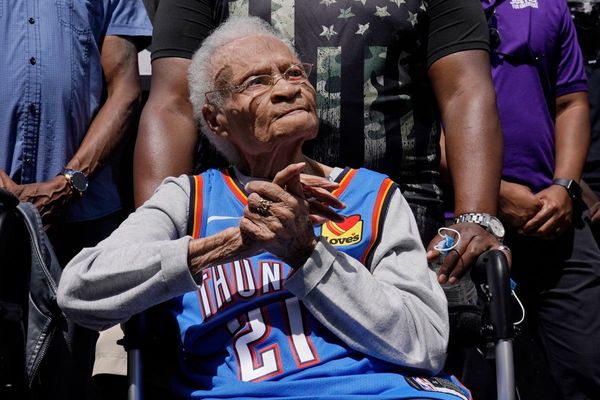
Just seven days on from IndyCar’s fastest and most prestigious race at the Indianapolis 500, the paddock journeyed just under 300 miles northeast to its shortest and bumpiest street track on the schedule.
The 1.645-mile Detroit track – using some sections that Formula 1 graced between 1982-’88 – boasts only five more corners than Indy’s fabled oval, and with an average pole speed some 136mph slower, making it the series’ starkest contrast in driving challenge.
After the majesty of Indy’s race for the ages, Detroit degenerated into a doleful crashfest last weekend. Following yellow after yellow – eight in all for 47% of the race distance – and during the most chaotic stage of the race Bryan Herta, one of the most sensible heads in the paddock, summed it up best: “I hate this.”
The laps-led report read: Josef Newgarden, Alex Palou 1; Christian Lundgaard 6; Kyle Kirkwood 24; Colton Herta 33; Scott Dixon 35. What it declined to mention was that Oriol Servia, the pace car driver, was in front for 47 of those!
Only 26 green flag laps had been run before a lap 73 restart, which mercifully ran to the checkered flag and somewhat saved the day for a pure racing spectacle.
So, who was to blame?

The drivers
There appeared to be some brain fatigue among many of IndyCar’s stars, but after only four days off from the rain-delayed Indy 500 to first practice around a vastly different street track, it was perhaps understandable that nerves were frayed.
The practice spat that blew up between Santino Ferrucci, Kirkwood and Colton Herta seemed symptomatic of that, with fuses on the short side in the cramped environment.
Apart from Romain Grosjean stomping to Ferrucci’s pit, qualifying ran pretty smoothly – but the race itself was a different story. When Will Power was tagged into a spin at the opening corner of the 100-lapper, it set the tone for a tedious sequence of clashes that blighted the race, mainly at Turn 3 – the first corner after the alternate start/restart line.
“Felt like Nashville,” sighed Power after the race, referring to IndyCar’s other street race that’s become its standard bearer for chaos – although it has dropped off the schedule for the foreseeable future.

“We're one of the best racing series in the world,” pointed out Detroit’s runner-up Marcus Ericsson. “We shouldn't be driving on top of each other every single restart.
“I saw in my mirrors every time on the restart, four, five-wide. I was just praying not to get hit pretty much every restart.
“I think people are driving reckless on the restarts. I'm sure it was dramatic and fun to watch. At some point also we need to have a bit of a better standard.”
His fellow podium finisher Marcus Armstrong agreed with that sentiment: “A lot of the moves today were very ambitious. Honestly, the braking distances are quite long. I think that's quite inviting. Perhaps it needs a bit of a rethink.”
I’ll exonerate IndyCar’s Race Control at this point, as the five penalties it handed out for avoidable contact were about right. There was no leniency excuse to be used.

The track layout and restart zone location
The circuit resides in the shadow of General Motors’ imposing towers of its Renaissance Center – which forms its global HQ – for good reason, with Chevrolet being the event’s title sponsor.
The ‘Motor City’ is the perfect place for a street racing festival but this tiny track’s blend of tight confines and unforgiving walls, combined with some boneheaded driving, contributed to a race that was a tough watch at times.
“You're in confined streets here,” mused winner Dixon after the race. “It's tough, man. You make any kind of mistake...”
Detroit GP chairman Bud Denker explained that its main location problem is finding 1000 feet for a pit lane, which it ingeniously halves with a unique split format, plus 20 acres of paddock space for the teams in a downtown environment that’s further complicated by an international border with Canada!

“That limits you on where you can do it,” said Denker. “We'd love to have gone down all the way past the Turn 3 hairpin, down to Huntington Place.
“Our original design was to go down there and come around. The problem is there's no runoff down there. Couldn't do that. That's why we have the course the way it is.
“We're not going to change the course. I think the course proved itself today and last year.”
Granted we’re stuck with the layout, I’ll raise the point that Saturday’s IMSA race used the regular start/finish line, on the short straight between Turn 9 and Turn 1, for its restarts.
That allowed the field to spread out, especially through the sweeping Turn 2 before the long drag to the Turn 3 pinch point – where most of the IndyCar collisions occurred.

IndyCar used the alternate startline for all its restarts too, and half of its eight cautions were for collisions at the tight hairpin that followed. That seemed to simply encourage trouble, just like its use of double-wide restarts on road and street tracks pre-2014. Worth a rethink?
Denker admitted he was a little torn by the amount of IndyCar cautions, and suggested it consider IMSA’s use of “quicky yellows” in future too, to get the action restarted in a timelier fashion.
“From a racer perspective, which I am first and foremost, I'd like to see more [green-flag racing],” he said, but then added: “From a promoter standpoint, nobody disappointed where I was.
“There was so much action going on. There were some divebomb moves there: What are they doing?! That caused a lot of excitement.”
It left some drivers hankering after the nearby Belle Isle circuit, which IndyCar left for this track last year…
Me too. https://t.co/JukWuIqGeF
— Graham Rahal (@GrahamRahal) June 2, 2024
…but to be fair to the promoter and the city, it had repaved a 700-foot stretch of back straight towards the Turn 3 braking zone and also smoothed the track at its final corner too.
Some concrete apexes were replaced by Armco barrier, which gave a little more room to open out the corners – and the lap times were appreciably faster than last year, despite harder tires.

The tires
This is not a dig at control supplier Firestone. Its arm was forced to bring harder compounds to road and street races to compensate for IndyCar’s move to heavier cars due to the electrical hybrid system. Oh yeah, the hybrid that’s delayed until Mid-Ohio in July!
Firestone’s lead times meant there was no rolling back on that one, and its primary tire in particular is incredibly durable. That led to drivers struggling to get the front tires warm, and with all those laps under caution, it likely contributed to those hairpin clashes.
“The tires this season have been very, let's say, robust,” said Armstrong. “You can't really generate temperature.
“Even towards the end of the stint it's not like they're in the right window. I think a lot of the mistakes are also caused by the fact that the tire is not working early in the run, especially when they're cold.
“I know I've taken some margin. If you brake where you think you should brake, occasionally you just drive straight through someone.”
To Firestone’s credit, the softer alternate tire (which Dixon believes was the primary used here last season) displayed a serious drop-off if you mistreated it. This was especially true if you started on the tire, following overnight rain that had made the track relatively ‘green’.

Witness Alex Palou’s tumbled down from second when he gambled on starting on used alternates and his rears grained badly, or Christian Lundgaard’s early charge up the order, only to fall back again.
“The first stint, I wanted to wheelspin the car more, which creates temperature, soaks the tires, you get some thermal heat,” analyzed Dixon. “It wasn't doing that. I think it was actually wearing the tire out.”
Kyle Kirkwood was the master of making the alternates last on that first stint, and the alternate really did its job from a strategic differentiator point of view.
Let’s absolve Firestone, while also giving the drivers some leeway for the tricky warm-up issues.

The weather
An element that nobody could control: It started sprinkling just before the start, a shower that blew over, before returning just before Scott McLaughlin’s shock exit into the tirewall.
Under that yellow, it rained hard but not for long. Even as some cars slithered off down the runoffs, the smart strategists put their faith in the weather apps that said it would again quickly blow over. And they were right.
“It was weird,” reflected Dixon, who stayed on slicks. “It would rain in [turn] two, rain in three, then kind of very wet [at] seven through eight. The front straight got really wet. It was moving a lot.
“I think with some of the temperature and the pavement, it being somewhat of a light shower, it did get very wet out there at one point. I was like ‘this is going to be really rough’.
“Luckily that caution ran on a little bit longer. Once we went back to green, it was fine.”
Remarkably, the rain didn’t cause a caution in itself – although McLaughlin and Colton Herta’s shunts were likely not helped by dampness, along with the Will Power/Rinus Veekay collision just after the rain had stopped.
Race control was very tardy in getting the race restarted as the rain abated, but at least that avoided the potential for the front seven cars restarting on slicks with 19 wet-shod cars behind them heading towards a soaked hairpin… The lesser of two evils, I think.

Conclusion
In truth, just about everyone and anything was partially to blame for contributing to the chaos that unfolded. IndyCar seemed quite pleased with its ‘excitement from start to finish’ claim on its video highlights on social media – although the comments below it seemed to argue otherwise!
When asked by Motorsport.com about the line of it being either action-packed or embarrassing for the sport, Dixon replied: “I don't think it's ever embarrassing. I think you do a survey, most people go to races to watch crashes. I don’t!
“I know when I watch some kind of NASCAR race, they have a similar kind of effect. It's obviously exciting. Obviously, you don't want to see the caution laps and them taking over.”
Statistically-speaking, IndyCar recorded 217 on-track passes last weekend – up from 189 last year. The inaugural event featured 32 laps under yellow compared to 47. “Fifteen more caution laps but much more passes,” noted Denker.
Not all races can be classics, and perhaps we were spoiled by such a pulsating Indy 500 that Detroit felt like a disappointing spectacle – apart from the final 27 laps, which provided more green-flag running than almost three-quarters of what had gone before!

Despite the criticism of what occurred on track, kudos to Denker and his crew – many of them volunteers – for making this event happen. And it certainly helps to keep GM invested in both IndyCar and IMSA, especially as it eyes an F1 future.
Half of the venue is open free of charge to spectators, catering for fans who’d likely never attend otherwise. And for that fact alone, Detroit deserves a better race next year.
But, then again, maybe the more casual fans simply enjoyed the wrecks? The purists can pretend it never happened and, instead, enjoy a true classic in Road America this weekend.







